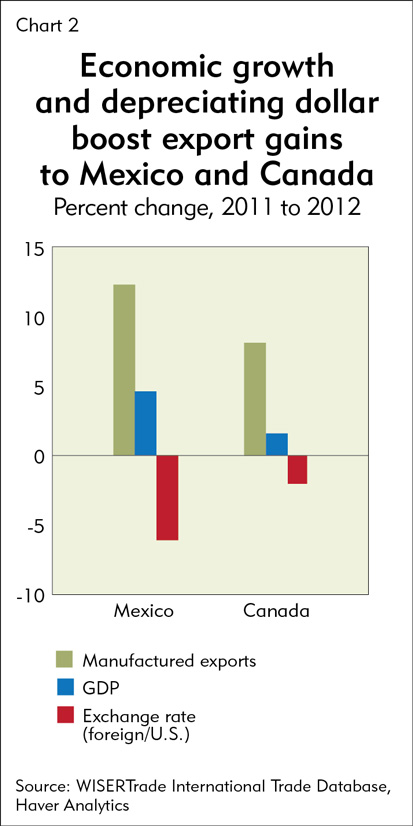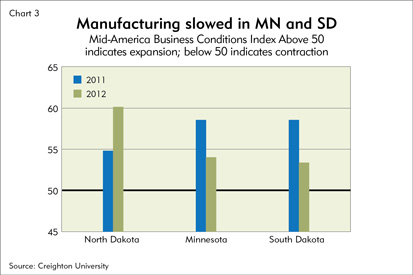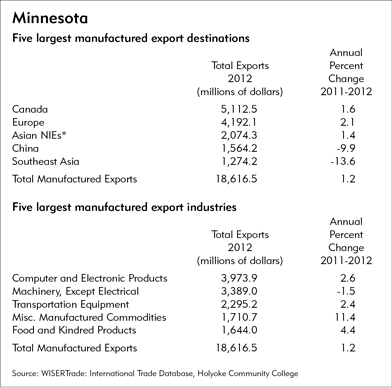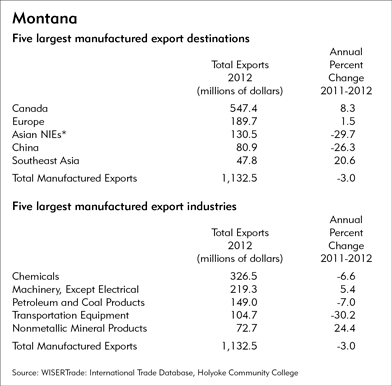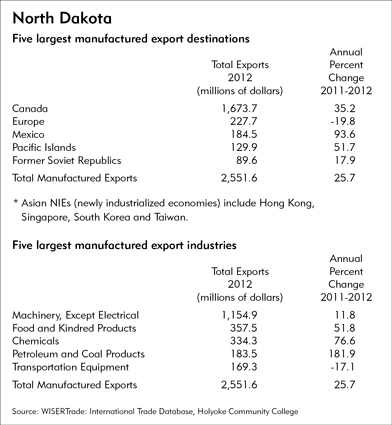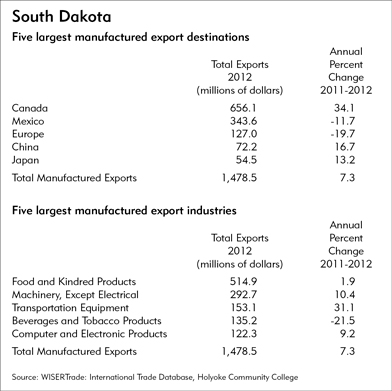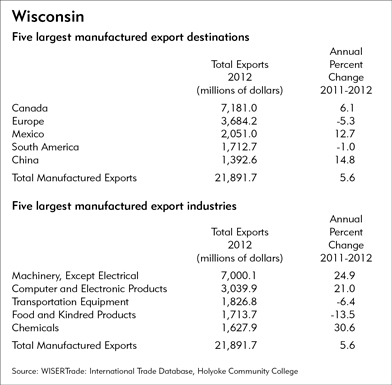Ninth District manufactured exports offered both some good news and some less-good news in 2012.
Exports across Ninth District states grew 4.5 percent during 2012, reaching a record $45.7 billion. But that positive growth rate was lower than the national average of 5.5 percent, and for the second year in a row, the annual growth rate dropped from the previous year. Manufactured exports grew over 10 percent in 2011 and 17 percent in 2010.
While district exports to Canada and Mexico remained strong, exports decreased to Europe and China, where economic activity slowed during 2012. Among district states, North Dakota posted the strongest increase at 26 percent, followed by South Dakota at 7 percent.
Solid growth to neighboring countries
Manufactured exports to Mexico and Canada showed solid gains of 13 percent and 8 percent, respectively. Canada is the district’s largest trading partner, receiving one-third of the district’s manufactured exports in 2012, while 8 percent were sent to Mexico (see Chart 1).
The economies of Canada and Mexico grew moderately during the year, which helped boost demand for district exports (see Chart 2). Furthermore, the U.S. dollar depreciated against the Canadian dollar and Mexico’s peso during 2012, which made district exports less expensive in these countries. The district’s top export to Canada is machinery, while food and kindred products top exports to Mexico.
Meanwhile, slower economic growth contributed to decreases in district manufactured exports to Europe (-2.4 percent) and China (-0.4 percent). During 2012, Europe’s gross domestic product decreased slightly, while China’s GDP growth slipped from over 9 percent in 2011 to below 8 percent in 2012. Even though China posted positive growth, the decrease in pace not only affected district exports, but also served as a drag on the global economy. District exports decreased to Europe and China despite a slight depreciation of the U.S. dollar relative to the euro and China’s yuan.
In other parts of the world, exports to Japan increased 11 percent in 2012 after decreasing slightly during 2011, the year of Japan’s devastating tsunami. Manufactured exports to the Pacific Islands (primarily Australia), the Middle East and the former Soviet Republics posted a second consecutive year of double-digit increases. However, these three regions combined represent only 8 percent of total district exports.
Exports to developing countries now account for a larger share of district exports. In 1997, the district shipped just 20 percent of exports to developing countries. In 2012, that level had grown to 33 percent. The majority of these gains were attributed to China and Mexico. Exports to China increased from 1 percent of district manufactured exports in 1997 to 7 percent in 2012, while Mexico increased from 3.5 percent to over 8 percent.
Slower growth in 2012
Growth in manufacturing output and employment contributed to the economic recovery following the Great Recession (see the October 2012 fedgazette). These gains were aided by solid growth in exports during 2010 and 2011. Last year, both manufacturing and exports were more sluggish. According to the Institute for Supply Management survey of manufacturers, the index averaged 51.7 in 2012, down from 55.2 in 2011. While 2012 was still above 50, which indicates growth, the manufacturing sector was far from stellar.
A regional survey of manufacturers by Creighton University (Omaha, Neb.) shows that manufacturing appeared to increase in strength in 2012 in North Dakota, whereas it appeared to decrease in strength in Minnesota and South Dakota while still remaining expansionary overall (see Chart 3).
Oil boom benefits North Dakota exports
North Dakota was the only district state to post higher growth in manufactured exports in 2012 (26 percent) than in 2011. In 2012, strong growth was recorded to Canada (35 percent), Mexico (94 percent) and the Pacific Islands (52 percent), while exports to Europe decreased (-20 percent).
The oil boom is helping to boost overall manufactured exports from North Dakota, as the state shipped almost all of its $184 million in petroleum and coal products (from refineries, not raw supplies) to Canada during 2012, up from $65 million in 2011. This category accounts for 7 percent of exports from North Dakota, still a modest component, but is likely to increase as oil and gas refining capacity expands in the state. Chemicals also posted strong gains in North Dakota last year, increasing by 77 percent.
While petroleum and coal products and chemicals supported gains in North Dakota, these categories lost ground in Montana, which was the only district state to post a decrease during 2012 (-3 percent). Exports of chemicals from Montana decreased over the past two years, and the state’s petroleum and coal product category posted a 7 percent decrease in 2012—this after 100 percent increases in both 2010 and 2011.





